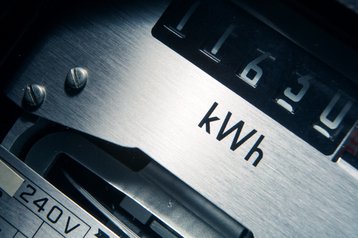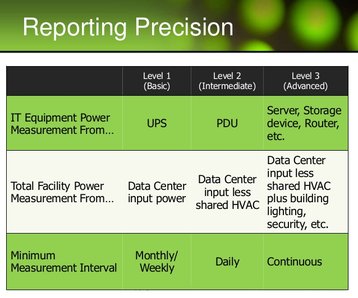Power Usage Effectiveness (PUE) is the widely accepted metric for the efficiency of the physical infrastructure systems that support the IT loads of a data centre. Calculated as the ratio of total energy expended by a facility to the energy consumed only by the IT systems, PUE helps data centre managers to assess and later to verify how efficiently they are managing their facility in terms of energy consumption.
There are many reasons for wanting to calculate and report PUE for a given facility, but in the long run the best is one of simple economics: the better you operate your infrastructure from an energy efficiency point of view, the more you save on energy costs.
How do you measure it?
There are several approaches to measuring or reporting PUE. One can make an estimate based on a model making assumptions about capacity, IT load and power and cooling system characteristics. One can take a “point-in-time” measurement to calculate a single value of PUE, or one can capture continuous measurements to see how PUE varies over time against variables such as weather conditions, changing IT loads and performance of cooling equipment.
For the most accurate calculation, the latter method is the most effective, although it can be more expensive than the others. It requires careful advance planning and preparation, the installation of meters throughout a data centre facility (if embedded meters don’t exist) and the operation of an appropriate management-software system to aggregate and analyse the collected data to provide regular reporting of the PUE metric.
The main power drain on a data centre, apart from the IT itself, is the cooling infrastructure necessary to maintain desired operating temperatures. It follows that minimising the energy expended on cooling is the top priority for any attempt to improve PUE.
Levels of precision
To calculate a useful PUE it is important to take measurements of electric and thermal performance throughout the facility. The Green Grid defines four levels of PUE reporting which vary in terms of accuracy, cost and metering complexity.
Levels 1 to 3 are concerned with continuous monitoring with 1 being the most basic, requiring metering only at the UPS level to measure IT equipment energy and at the utility input to measure overall facility energy. The minimum required frequency for measurements is one month.
Level 2 is the intermediate stage which requires measurements to be taken daily at a minimum. Here, measurements of how much energy the IT equipment is consuming must be taken at the output of power distribution units (PDUs) or remote power panels (RPPs).
Both of these cases allow data to be gathered relatively cheaply. It is common for UPS systems, PDUs, and RPPs to have embedded meters which can perform the necessary measurements and so there is no additional metering needed.
The greater accuracy provided by Level 2 methodology is necessary if non IT loads are being powered from the UPS. If the UPS is only powering IT systems, then its embedded meter reading can be a reasonable approximation of the power consumed by IT equipment only and Level 1 can be sufficient for PUE reporting. If, however, units such as air handlers are also being powered by the UPS then this assumption is no longer valid and will result in an inaccurate PUE calculation. Therefore the Level 2 approach of taking readings at the PDU level is necessary to split out the power measurements for IT equipment only.
The best reason for wanting to calculate and report PUE is simple economics: the more energy efficient your infrastructure is, the more you save on energy costs
At the most advanced Level 3, measurement intervals are reduced to 15 minutes and power metering is more precise still. To measure energy consumed by IT equipment alone metered rack PDUs are placed in every rack and their readings summed together.
Granular measurements
Also, calculation of the power consumed by the physical infrastructure can require more granular measurements if a data centre is part of a mixed-use facility. This is because a simple measurement of the power at the utility input is insufficient and additional meters may have to be installed on individual pieces of equipment such as chillers and air handlers to measure what percentage of the load supported by those systems is devoted to the data centre facility.
Another consideration is that data centres change over time both in terms of load and layout and so does the electrical infrastructure that supports them. It is therefore necessary to have up to date documentation describing the circuits in the facility, what equipment they serve and how they are to be assigned to accurate calculation of PUE. Tracing the circuits is an valuable prelude to installing any metering necessary for acquiring accurate data.
To aggregate the data from all meters and to calculate PUE on a regular basis requires the use of a good Data Centre Infrastructure Monitoring (DCIM) system. Once deployed, DCIM can provide an accurate continuous measurement of PUE to help you see not only what your PUE is today, but also how it will vary over time with changing IT load, weather, and cooling performance .
Wendy Torell is senior research analyst at Schneider Electric’s Data Center Science Center
To download a free copy of Schneider Electric White Paper #204, “Continuous Metering and Monitoring of PUE in Data Centers” please click here.



